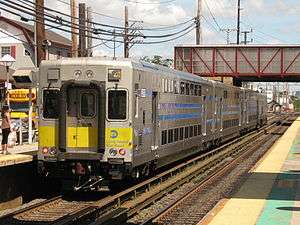C3 (railcar)
The C3 is a bi-level coach railroad car built by Kawasaki. These cars began delivery in 1997, ordered by the Metropolitan Transportation Authority for the Long Island Rail Road. The rail cars are pulled and pushed by EMD DE30AC and EMD DM30AC over both electrified and non-electrified territory.[3]
| C3 | |
|---|---|
 C3 cab car #5019 trailing at Mineola | |
| In service | 1998-present |
| Manufacturer | Kawasaki Rail Car, Inc.[1] |
| Replaced | all C1 bi-levels and MP75 single-levels |
| Constructed | 1997-1999 |
| Entered service | Fall 1998 |
| Number built | 134 cars C car with toilet, 23 T cars (no toilets), 67 TT car with toilet, 44 |
| Fleet numbers | C car, 5001-5023 T car, 4002-4134 (even numbers)) TT car, 4001-4087 (odd numbers) |
| Capacity | Seated passengers[1][2] C car, 137 T car, 143 TT car 137 |
| Operator(s) | Long Island Rail Road |
| Line(s) served | Ronkonkoma Branch Port Jefferson Branch Oyster Bay Branch Montauk Branch |
| Specifications | |
| Car length | 85 ft 0 in (25,910 mm) |
| Width | 9 ft 10.5 in (3,010 mm) |
| Height | 14 ft 5.59 in (4,409 mm) |
| Maximum speed | 100 mph (161 km/h) |
| Weight | C Car, 148,771 lb (67,481 kg) T Car, 141,375 lb (64,127 kg) TT Car, 144,338 lb (65,471 kg) |
| Power supply | 480 V AC 60 Hz |
| Coupling system | Type H tightlock knuckle coupler |
The C3 cars are powered by 480 V AC Head End Power (HEP) supplied from the locomotive through four train lines. The 480 VAC HEP is supplied to the HVAC system, low voltage power supply, and 240 V AC single-phase transformer, and the 120 V AC three-phase transformer. The low voltage power supply provides 74 V DC power for the doors, communications, toilet, and control circuits.[2][3]
There are three types of C3 cars: cab car with toilet (C Car), trailer car (T Car), and trailer car with toilet (TT car). The C car is normally at the opposite end of a consist from the locomotive. The T and TT cars are always between two locomotives or between a locomotive and a C car. The C3 cars can be operated at speeds of up to 100 mph in push and/or pull operation. All cars within a consist must be facing the same direction.[1][2][3]
The cars are connected to one another by a mechanical type H tightlock knuckle coupler. All trainlined electrical connections between the cars are made through six trainline jumper cables. Air connections between the cars are made through two air hoses, brake pipe and main reservoir.[2] [3]
The C3s are the first trains on the LIRR to feature automated announcements with LED destination sign displays, announcing the current station, following station, and destination along the routes. However, over the years of service the components often fell into disrepair, consequently requiring the train crew to make announcements.
See also
References
- "Kawasaki LIRR BI-Level from Kawasaki Rail Car Inc. Website". Archived from the original on July 26, 2010. Retrieved August 1, 2011.
- BI-LEVEL C-3 CARS Operator's Manual, Transit Documentation Consultants, Jan 2000
- Kawasaki Rail Car Inc.